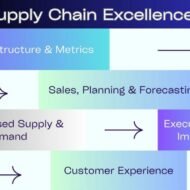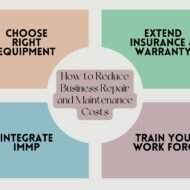Currently Browsing: Supply Chain Management
Posted by Managementguru in Operations Management, Project Management, Supply Chain Management, Technology
on Mar 27th, 2024 | 0 comments

In the current business environment, an efficient supply chain management process can be a key differentiator. Streamlining your supply chain reduces costs and enhances customer satisfaction and overall business performance. Here are some strategies to improve your supply chain management process. Embrace Technology Incorporating cutting-edge technologies like AI, IoT, and blockchain can revolutionize your supply chain. These technologies can enhance visibility, optimize inventory management, and automate processes, leading to improved efficiency and reduced costs. Leveraging technology allows businesses to adapt quickly to changing market conditions and customer demands. Enhance Collaboration Collaboration with suppliers, manufacturers, and distributors is essential for a smooth supply chain. Implementing collaborative tools and fostering strong relationships can lead to better coordination, faster problem resolution, and increased agility. Strong collaboration ensures that all parties are aligned with the overall supply chain goals, improving overall performance. Integrating Efficient Logistics Efficient logistics management is crucial for a streamlined supply chain. For example, platforms like Shiply connect shipping companies with clients, offering cost-effective and efficient shipping solutions. By leveraging Shiply and other advanced logistics technologies, such as transportation management systems (TMS) and warehouse management systems (WMS), businesses can optimize their logistics operations.Efficient transportation management leads to lower shipping costs and improved delivery times, while effective warehouse management minimizes inventory holding costs and ensures timely order fulfillment. Integrating logistics with other supply chain functions improves coordination and visibility, enhancing overall performance and customer satisfaction. Efficient logistics management also allows businesses to scale their operations as well as enter new markets more easily. Focus on Data Analytics Data analytics can offer valuable insights into the performance of your supply chain. By analyzing data, you can identify inefficiencies, forecast demand more accurately, and make informed decisions to optimize your supply chain operations. Data-driven decision-making helps businesses stay competitive and agile in the market. Implement Lean Principles Implementing lean principles, like just-in-time inventory management and continuous improvement, can eliminate waste and enhance efficiency. Lean practices can streamline processes, reduce lead times, and enhance overall productivity. Continuous improvement ensures that the supply chain is constantly evolving so that it can meet the changing needs of the business and customers.Implementing just-in-time inventory management reduces excess inventory, minimizing storage costs and the risk of obsolescence. Streamlining processes reduces waste and enhances flexibility, enabling the supply chain to quickly adapt to market changes. Continuous improvement nurtures a culture of innovation and efficiency, leading to ongoing enhancements in the supply chain’s performance. Prioritize Sustainability Adopting sustainable practices not only benefits the environment but also leads to cost savings and enhances brand reputation. Incorporating sustainable sourcing, packaging, and transportation methods can reduce carbon footprint and enhance supply chain resilience. Prioritizing sustainability ensures that the supply chain is resilient to external shocks and contributes positively to the environment. Businesses can achieve cost savings through reduced waste, energy efficiency, and lower resource consumption. Moreover, consumers increasingly prefer environmentally conscious brands, leading to enhanced brand reputation and customer loyalty. Embracing sustainability also future-proofs the supply chain, ensuring its viability in the face of changing regulations and market demands. Incorporating sustainable practices aligns with corporate social responsibility (CSR) goals, showcasing a dedication to environmental stewardship and social...

Posted by Managementguru in How To, Productivity, Sales, Supply Chain Management
on May 9th, 2023 | 0 comments

If there are blockages in your supply chain, then this will filter down throughout your business. It will end up being passed on to customers and clients. This can be frustrating, but it can also be unprofessional too. Avoiding this situation in the first instance by continually improving the supply chain and management, therefore, must be a high priority. Don’t Go It Alone – Reach Out to Consultants Taking control of a supply chain and making changes may be something that you want to avoid at all costs. If you have little experience and knowledge about how to implement changes and developments, then do not hesitate to reach out to trained and experienced consultants. Experts can help you understand Six Sigma Manufacturing, and they can help you see how it can be applied to the supply chain that exists in your business. Feeling alone when making improvements or changes is not necessary. Strong networks with other business owners and managers will also prove to be advantageous at this key stage. Monitor the Supply Chain at Regular Intervals To get the most efficient supply chain, you are going to have to invest effort and finances into monitoring. Watching what is always happening in the supply chain (and levels) will give you the opportunity to grow and develop. If you are not monitoring the supply chain, then how can you see where change and improvement are needed both now and moving forwards? Be Open to Change The right attitude and approach are important when it comes to management. If you are not open to change and you are not ready for change, then you will find that your supply chain will remain stagnant. Seeing the benefits of change and adopting an approach and mindset that allows for change is therefore crucial. If you are not open to change and you struggle to adopt new ways of thinking and working, you will hinder the management and operations of the supply chain. This reluctance to change can also impact future growth. Implement Streamlined Processes Your supply chain may be working now, but could it be streamlined? If you can streamline one or two of the processes, you could save time (and financial resources). Streamlined processes can help you stay on top of the supply chain and help you manage it with ease. If you are not fully investing in streamlining, then you may be trying to manage an out-of-date supply chain. Streamlined processes may be introduced within several areas, such as data and inventory management. Focus on Being Proactive The supply chain and management within a business are not going to change or improve if you are not focused on being proactive. Being reactive is OK in business, but not when you are looking at how (and where) to make improvements. If you are not proactive with your time and efforts, you may find that you overlook an opportunity. This is going to be a costly mistake that may end up having a knock-on effect on a...

Posted by Managementguru in Business Management, How To, Supply Chain Management, Training & Development
on Dec 13th, 2022 | 0 comments

If your business doesn’t have a proper maintenance management strategy in place, it’s going to cost a fortune, turn customers over to competitors, and damage your company’s image. Maintaining equipment regularly will cost money, but it will be much less expensive. To help your business start saving money and time today, we’ve put together this short guide to reducing maintenance and repair costs. Prevent Breakdowns You guessed it – the best way to reduce the cost of repairs is to avoid them in the first place. To do this, you will need to carry out regular maintenance and checks. You can implement a solid maintenance strategy by using a CMMS, which tracks all tasks and provides a range of other functions. Alternatively, you can integrate an IMMP (Intelligent Maintenance Management Platform), which can schedule, review, and track all tech operations. When equipment gets too old, it will likely break down regardless of your maintenance schedule. For example, an old forklift may face cooling problems, faulty wiring, running rough, and several other hazardous malfunctions. If this happens, you should get in touch with a professional forklift repair service, which may be able to rejuvenate it. Train Your Workforce If you’ve got a team of mechanics on site, that’s fantastic. However, the best way to ensure proper ongoing maintenance is carried out is to train your entire team. If everyone knows how to spot signs of failure, there’s less chance of malfunctions going unnoticed. Naturally, you will need to invest money and time in training, but it will cost less than regular repairs and unnecessary maintenance. Track Inventory When equipment is out for repairs, it has the potential to delay operations, which damages your bottom line. If repairs are taking too long, the chances are you need to improve your inventory management. By checking inventory regularly, you’ll know which parts need ordering. As well as speeding up repairs, you will likely receive a discount for ordering parts in bulk. Extend Insurance and Warranty When you operate expensive insurance, you need to know that the manufacturer will cover any faults that weren’t caused by your team. To do this, you can check warranties and extend them if need be. Additionally, you should consider having insurance, which will help alleviate the financial burden of breakdowns. Choose The Right Equipment You’ve likely heard the saying “You get what you pay for!” – the same is true for business equipment. If you choose to cut corners and source machinery from questionable dealers, you’ve got no one to blame when it malfunctions early and costs a fortune to replace. The best practice is to buy from reputable brands in the first place. Conclusion All businesses rely on equipment, whether it’s heavy machinery, computers, or smartphones. When equipment fails, it’s costly to repair or replace. To avoid these costs, proper maintenance management needs implementing. To help get off on the right foot, observe the methods above and watch your repair and maintenance outgoings...

Posted by Managementguru in Business Management, How To, Operations Management, Supply Chain Management
on Dec 13th, 2022 | 0 comments

The dairy industry is facing many problems, now more than ever. For example, supply issues, climate change, and fluctuating consumer demand are all playing a part. Many of these challenges are outside of the scope of what the manufacturer and/or farmer can alter. That said, there is still leeway to bring about improvements and keep your business on track. We look at some of the recent obstacles and provide suggestions on how to handle them. Sustainability With the focus on sustainability, all producers are in the spotlight and expected to use scarce power and water responsibly. The hype also touches on the well-being of dairy animals, farming and production methods, as well as the type of packaging being used. All resources must be ethically sourced. Waste and carbon footprint must show a marked decline and how waste is dealt with is also important. Processes need to be scrutinized and adapted if necessary. Customers are turning to producers who take sustainability seriously and rejecting those who are not falling in line. Managing Product Variety Many manufacturers are producing more than one product. Then, it becomes essential to determine how to handle multiple lines for efficiency without contamination. Adverse consumer responses to just one product can affect the whole business. Quality and Safety Quality and safety are the buzzwords manufacturers need to pay attention to. You just cannot afford to make mistakes as this will impact your entire business. Choosing equipment designed for hygiene in the manufacturing process can keep your company in the green. For example, a slurry circulating pump that meets the hygiene requirements of the dairy industry is essential. Fluctuating Demand and Supply Chain Disruptions Little can be done to combat the rise in consumers insisting on vegetarian products instead of meat and dairy. Demand within the dairy industry is being reduced, causing competition among manufacturers and it is becoming harder to stand out unless you have great products that tick all the boxes and no negative feedback. At the same time, the Covid pandemic has caused major disruptions to the supply chain. What can dairy manufacturers do to sustain their businesses? Here are some moderating factors worth considering. Equipment Use equipment that is designed to deal with the challenges inherent in processing dairy products. These should ensure 100% hygiene (see above), and they must be accurate and quick to use. Get advice from expert suppliers if you are unsure of the optimal products for your operations. Manufacturing dairy requires optimal temperatures and, again, the right equipment for that is essential. With many delicate processes required to produce a perfect, safe, and hygienic product, processes and equipment must work correctly together. Use the right tools for the job, as the saying goes. This will also reduce wastage and by-products that must be disposed of correctly. Agility When you are producing a multitude of separate products at one plant, you need to pay careful attention to each line. This will ensure consistent productivity. It also means determining the perfect equipment solution and/or integration for each step and ensuring that there is no cross-contamination. Eco-Friendly Manufacturing Audit every aspect of your production lines and processes to reduce waste. This includes superior products and minimal wastage on poor quality produce that has to be thrown out. Only do business with sustainable-minded partners. Use equipment with lower energy consumption. Speedier processes will also reduce the use of power. Use eco-friendly packaging. While some obstacles are beyond your power to overcome, following this guide will maximize your overall performance and produce some...

Posted by Managementguru in Operations Management, Supply Chain Management
on Oct 31st, 2022 | 0 comments

Manufacturing managers have a lot of responsibilities. The flow of production runs through them, and their decision-making skills can have tangible consequences on the balance sheet of a business. With these three skills mastered, any manufacturing manager can become the engine that powers a successful business. Supply Chain Management This is one of the most important skills a manufacturing manager needs. No matter what sector of the manufacturing industry you work in, the manufacturing team is a part of a supply chain. Materials come in, and products go out. You need to be able to handle the logistical challenges that come with managing the constant flow of both raw materials and the finished product. The speed of this flow governs the capacity and potential of the business. The more you can do in less time, the more capacity and potential for profit your manufacturing process has. Product Development and Knowledge Not only do you need to know a lot about the products you are manufacturing, but you also need to have a knowledge of products, production processes, market demands, and methods of product development. Your position as a manufacturing manager puts you in a unique position to understand how a product is manufactured, and why. You can use your experience to inform both design and marketing processes to help develop better products that give more value to customers while being simpler to produce. At this level of management, you need to have a wider view of the business to make better decisions and better products. You can learn more about product development with ICAgile certifications in Product Ownership, get certification in your existing skills, and become a recognized expert in your field. This can be very beneficial to your resume, and your role in your workplace. Leadership and Team Building When people think of the manufacturing process, they often think of large machines that build a product piece by piece on a long, automated line that weaves its way through a warehouse. The truth is that a manufacturing process is only ever as good as the people that operate it. You can have highly efficient machinery, and automate nearly all of its processes, but without the right operation, they are useless metal. Manufacturing managers need to be able to both hire and inspire. You will be involved in the hiring process and must be able to spot signs of a good worker who will fit in with the team. You need to inspire the team daily too. The work on a production line, and all across the manufacturing process, can become monotonous, much more than the average job. It has huge benefits though and can be a lot of fun. If you work hard at keeping your workers enthused and involved, you will be able to grow both as a manager and as a business. These skills will all help you to develop as a manufacturing manager and be successful at it. You need to carefully balance the management of man and machine so that they can work in harmony together. Become an expert in your field by honing these skills and using them to push up your production...










